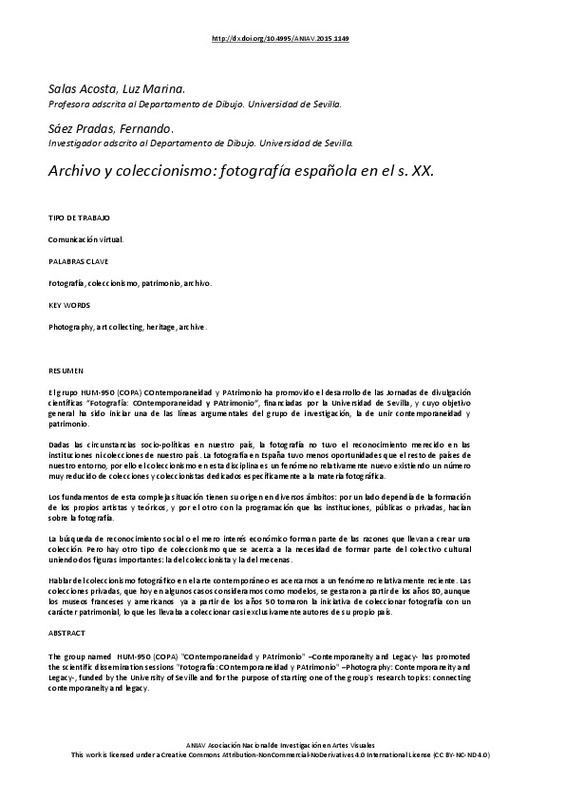JavaScript is disabled for your browser. Some features of this site may not work without it.
Buscar en RiuNet
Listar
Mi cuenta
Estadísticas
Ayuda RiuNet
Admin. UPV
Archivo y coleccionismo: fotografía española en el s. XX
Mostrar el registro sencillo del ítem
Ficheros en el ítem
| dc.contributor.author | Salas Acosta, Luz Marina
|
es_ES |
| dc.contributor.author | Sáez Pradas, Fernando
|
es_ES |
| dc.date.accessioned | 2017-10-30T10:29:37Z | |
| dc.date.available | 2017-10-30T10:29:37Z | |
| dc.date.issued | 2015-11-26 | |
| dc.identifier.isbn | 9788490483411 | |
| dc.identifier.uri | http://hdl.handle.net/10251/90244 | |
| dc.description.abstract | [EN] The group named HUMG950 (COPA) "COntemporaneidad y PAtrimonio" –Contemporaneity and Legacy- has promoted the scientific dissemination sessions "Fotografía: COntemporaneidad y PAtrimonio" –Photography: Contemporaneity and Legacy-, funded by the University of Seville and for the purpose of starting one of the group's research topics: connecting contemporaneity and legacy. Due to the social and economic situation in our country, photography was never adknowledged by the Spanish establishment or collections. Photography in Spain had less opportunities than it had in countries in our area, which is the reason why collection is a fairly new discipline and there is such a small number of collections and collectors specifically involved in the subject of photography. The foundations for this complex situation are based on several fields: on the one hand it depended on artists and theorists' training and on the other hand it depended on the photography schedule planned by the public or private establishment. The search for social appreciation or even just the economic concern are part of the reasons which lead to the origination of a collection. But there is a different way of collecting which approaches the need for being part of the cultural collective. This is achieved by joining two important characters: the collector and the patron. Talking about photography collecting in contemporary art makes us think about a relatively recent trend. Private collections, which are sometimes thought of as models, have been devised since the 1980s despite the fact that French and American museums led the way in collecting art on a patrimonial base since the 1950s. This took them to collect works by nearly exclusively their fellow countrymen. | es_ES |
| dc.description.abstract | [ES] El grupo HUM-950 (COPA) COntemporaneidad y PAtrimonio ha promovido el desarrollo de las Jornadas de divulgación científicas “Fotografía: COntemporaneidad y PAtrimonio”, financiadas por la Universidad de Sevilla, y cuyo objetivo general ha sido iniciar una de las líneas argumentales del grupo de investigación, la de unir contemporaneidad y patrimonio. Dadas las circunstancias socio-políticas en nuestro país, la fotografía no tuvo el reconocimiento merecido en las instituciones ni colecciones de nuestro país. La fotografía en España tuvo menos oportunidades que el resto de países de nuestro entorno, por ello el coleccionismo en esta disciplina es un fenómeno relativamente nuevo existiendo un número muy reducido de colecciones y coleccionistas dedicados específicamente a la materia fotográfica. Los fundamentos de esta compleja situación tienen su origen en diversos ámbitos: por un lado dependía de la formación de los propios artistas y teóricos, y por el otro con la programación que las instituciones, públicas o privadas, hacían sobre la fotografía. La búsqueda de reconocimiento social o el mero interés económico forman parte de las razones que llevan a crear una colección. Pero hay otro tipo de coleccionismo que se acerca a la necesidad de formar parte del colectivo cultural uniendo dos figuras importantes: la del coleccionista y la del mecenas.Hablar del coleccionismo fotográfico en el arte contemporáneo es acercarnos a un fenómeno relativamente reciente. Las colecciones privadas, que hoy en algunos casos consideramos como modelos, se gestaron a partir de los años 80, aunque los museos franceses y americanos ya a partir de los años 50 tomaron la iniciativa de coleccionar fotografía con un carácter patrimonial, lo que les llevaba a coleccionar casi exclusivamente autores de su propio país. | es_ES |
| dc.format.extent | 4 | es_ES |
| dc.language | Español | es_ES |
| dc.publisher | Editorial Universitat Politècnica de València | es_ES |
| dc.relation.ispartof | II CONGRESO INTERNACIONAL DE INVESTIGACIÓN EN ARTE VISUALES | es_ES |
| dc.rights | Reconocimiento - No comercial - Sin obra derivada (by-nc-nd) | es_ES |
| dc.subject | Arte | es_ES |
| dc.subject | Producción artística | es_ES |
| dc.subject | Estética | es_ES |
| dc.subject | Teoría del Arte | es_ES |
| dc.subject | Gestión cultural | es_ES |
| dc.subject | Educación artística | es_ES |
| dc.subject | Investigación artística | es_ES |
| dc.title | Archivo y coleccionismo: fotografía española en el s. XX | es_ES |
| dc.type | Capítulo de libro | es_ES |
| dc.type | Comunicación en congreso | es_ES |
| dc.identifier.doi | 10.4995/ANIAV2015.1149 | |
| dc.rights.accessRights | Abierto | es_ES |
| dc.description.bibliographicCitation | Salas Acosta, LM.; Sáez Pradas, F. (2015). Archivo y coleccionismo: fotografía española en el s. XX. En II CONGRESO INTERNACIONAL DE INVESTIGACIÓN EN ARTE VISUALES. Editorial Universitat Politècnica de València. 959-962. https://doi.org/10.4995/ANIAV2015.1149 | es_ES |
| dc.description.accrualMethod | OCS | es_ES |
| dc.relation.conferencename | II Congreso Internacional de Investigación en Artes Visuales. |< real | virtual >| ANIAV2015 | es_ES |
| dc.relation.conferencedate | July 09-10,2015 | es_ES |
| dc.relation.conferenceplace | Valencia, Spain | es_ES |
| dc.relation.publisherversion | http://ocs.editorial.upv.es/index.php/ANIAV/ANIAV2015/paper/view/1149 | es_ES |
| dc.description.upvformatpinicio | 959 | es_ES |
| dc.description.upvformatpfin | 962 | es_ES |
| dc.type.version | info:eu-repo/semantics/publishedVersion | es_ES |
| dc.relation.pasarela | OCS\1149 | es_ES |








